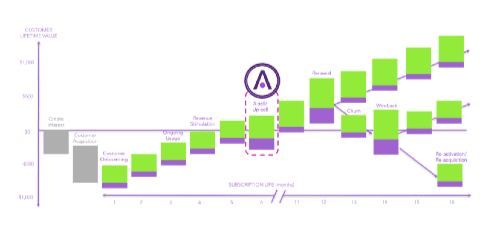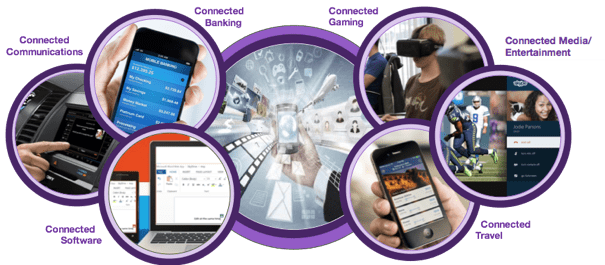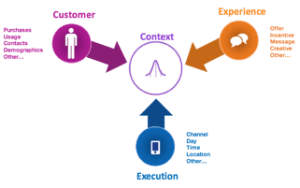
In the beginning there was Marketing — the activity and processes for creating, communicating, delivering, and exchanging offerings that have value for customers, clients, partners, and society at large.
And lo, the practice of marketing spread across the business landscape — and it was good.
Marketing soon begat Direct Marketing, the targeting of marketing strategy and messaging to address one or more segments of a population, usually with a postage stamp.
To identify the most responsive target markets, direct marketing mailing list sources were culled and geo-demographic and psychographic overlays were applied to match select offers with particular audience slices. And, yea, out of the valley of the shadow of unenlightened response rates arose the peaks of the vaunted “control package,” the victor in the marketing game of thrones until another king came along to topple it.
With Digital Marketing came the velocity to test any number of variables at the speed of a click. The science of marketing automation and predictive marketing analytics was born, exploding like a supernova. The ever-expanding Internet created mountains of data, called “big data” by some. Data-miners laid claim to a process of mass customization, the ability to tailor a uniquely personalized message to customers on a global scale. “Amazon shoppers who liked this product also liked X.”
Now we have arrived at the dawn of a new era where Machine Learning-Based Marketing Automation can accelerate the number of marketing tests against a panoply of business goals. Seattle has become a testbed for the new technology with Amplero as one of its most ardent progenitors.
One of Amplero’s wisemen is Chief Marketing Officer Matt Fleckenstein. We caught up with Matt for an up close look at the latest generation of digital marketing intelligence.
Seattle24x7: Matt, before we fast-forward to the new age of Amplero Marketing Automation, let’s get back-to-basics. How do you define “Marketing” in the traditional sense of the word?
Fleckenstein: Marketing has traditionally been defined as a form of communication between a company and its potential customers with the goal of selling them a product or a service. But our consumption patterns are changing. Managed services are eating the world.
Instead of buying music, we subscribe to services like Spotify or Pandora. Instead of owning a car, we use services such as Uber or Lyft to secure our own personal drivers. Instead of buying software on a DVD that we install on our computer, we subscribe to software-as-a-service getting real-time feature updates and improvements pushed to our computers (as long as we keep paying.
As the world increasingly moves to services, the focus of marketing is no longer just about selling goods or services, but engaging, retaining, and continually delighting paying customers to ensure they continue to utilize and pay for those services. We are living in the age of managed services where retention marketing is becoming more important than acquisition marketing.
Seattle24x7: Would you say that engagement and retention are the determinative characteristics of “Online Marketing?”
In terms of marketing vs. online marketing, traditionally, these lines have been very distinct. Online marketing focused on users on the web, typically accessing it from a computer. Marketing was much broader and included everything from newspaper advertising to out-of-home advertising (think billboards) to television commercials.
![]() But, in our increasingly connected world, those lines are blurring quickly. If a customer walks into a high-end retailer to buy apparel, that has traditionally been a “marketing” experience. Offline marketing techniques such as television or radio ads helped raise awareness of the brand (or the store) and helped get that customer in the door. A human being smiled and greeted the customer and worked to be as helpful as possible in the interest of closing a sale. But, in today’s world, the digital and physical worlds are blending, which means traditional marketing and online marketing are blending as well.
But, in our increasingly connected world, those lines are blurring quickly. If a customer walks into a high-end retailer to buy apparel, that has traditionally been a “marketing” experience. Offline marketing techniques such as television or radio ads helped raise awareness of the brand (or the store) and helped get that customer in the door. A human being smiled and greeted the customer and worked to be as helpful as possible in the interest of closing a sale. But, in today’s world, the digital and physical worlds are blending, which means traditional marketing and online marketing are blending as well.
Today, when you walk into a retailer, geo-fences and beacons inform marketers how you are navigating through their store and what goods/services you may be considering but not purchasing. The sales agent who approaches you to ask if you need help, may well know who you are based upon your mobile app identity and have several recommendations to offer you based upon your unique/individual interests.
Seattle24x7: How would you distinguish the first generation of “Marketing Automation” with the current generation of “Machine Learning-based Marketing Automation?” By the way, is there an abbreviated term for “Machine Learning-based Marketing Automation?”
Fleckenstein: Yes, machine learning-based marketing automation is certainly a mouthful isn’t it? The good news is that we really need a new word for it anyway given that the term marketing automation has a very specific (and fairly restrictive) definition. Marketing Automation has traditionally been a very rules-driven type of an approach focused on helping companies to capture manage, score, and market to B2B prospects.
In these approaches, a marketer is asked to pre-determine all of the potential scenarios that could play out to warrant an automated message being delivered (e.g., if the user abandons a shopping cart and they are in industry Y and have spent amount X previously, then send this message). Perhaps that approach can work in B2B, but I have seen it fail fantastically in the B2C realm for two key reasons:
- It is impossible for a marketer to know what message/offer to send to which users at which point in time before ever having run a given campaign
- It simply doesn’t scale — I’ve seen large consumer companies try and run 1000’s of these rules-based campaigns to get to the proper level of targeting, and they spend all of their time/resources just managing and tweaking rules (vs. being a marketer)
The current, modern approaches leverage machine learning for nano-segment testing and continuous optimization. Rather than predetermining (based upon gut calls/intuition) what will/won’t work, they can rapidly conduct 1000’s of tests to determine what actually works with consumers for a given marketing program. In essence, these approaches can sit seamlessly in between a company’s data stack and their marketing technology stack. They function as an intelligent, self-learning marketing optimization layer helping companies to optimize and maximize the value of their existing data and marketing tools investments. So, we refer to this space as “digital intelligence” — adding a layer of intelligence to all digital interactions between your company and your customers.
Seattle24x7: Is “Big Data” a prerequisite for mining this digital intelligence?
Fleckenstein: For years, companies have had systems of record — their data warehouses. Over the past 4-5 years, almost every large enterprise has invested in expanding those data warehouses to make them “big data” compatible so that they could collect the tera-/petabytes of rich signals generated by today’s connected customer. They have also had systems of engagement— various marketing tools/channels — which are expanding at an exponential rate to engage customers at every interaction across the customer journey.
But, there remains a big divide. The data collected and sitting in a big data store can not easily and intelligently be leveraged to deliver an optimal interaction experience across those various marketing tools/channels. Over the past decade, companies have used mass segmentation tools and/or rules-based approaches to try to connect their system of record with their system of engagement to create great customer experiences. But such approaches don’t scale. They help move us from macro-segments (using traditional segmentation tools) to micro-segments (using rules-based approaches), but they still fell ridiculously short of the promise of 1:1 marketing.
Thanks to machine learning and continuous optimization, that is changing rapidly. Customer-obsessed consumer industries such as telecom, banking, consumer software, gaming, media/entertainment, and more are looking to maximize the value of their systems of engagement and their systems of record to meet the increasing demands of today’s connected customer. To do so, the leading companies are investing in systems of intelligence. We see this in terms of sales with companies like 6sense (sales intelligence). We see this in terms of more efficiently/effectively running data centers with companies like Splunk (operational intelligence). And, with companies like Amplero, we are seeing this across every interaction a company has with their customers (digital intelligence).
Seattle24x7: How has testing truly differentiated machine-learning-based marketing campaigns fared against more conventional marketing automation systems or control groups?
Fleckenstein: Testing against control groups is a foundational piece in every campaign run on our system. Marketers can use our intelligence platform to identify the KPI they want to optimize — say customer lifetime value, 45-day increase in average revenue per user, X% decrease in churn, etcetera. Then, our system recursively tests 1000’s of permutations playing variations of customer nano-segments with different creative, offers, channels, message sequencing, etc.
The success of these 1000’s of tests are all constantly measured against KPI lift (how much did we move the needle) relative to at least one control group. That control group could be “marketing as usual” using their current marketing tools, a universal control group (a small group that gets no marketing at all), a challenger group (e.g., a group of internal data scientists trying to drive lift via modeling), or in some cases all of these.
Seattle24x7: Does Amplero’s brand of marketing automation continually improve on it and “beat the control?”
Fleckenstein: The Amplero Intelligence Platform is not just about beating the control. Our continuous testing and adaptive marketing approach works to continually beat itself. There is no resting on our laurels. If we are driving a 5x increase in Average Revenue Per User, the platform will play the marketing interactions that it knows drive revenue more frequently than those that are uncertain, but it does continue to explore and test the unknown as there may be bigger pockets of lift that have yet to be found. Collectively, this balancing of playing the known winners while continuously testing the unknown (our multi-armed bandit approach) can be proven to mathematically optimize the desired KPI lift and as such shows ongoing improvement.
Seattle24x7: What differentiates one machine learning-based marketing services provider from another? Is this an industry of parity, or are there different techniques or methodologies that each employ? What differences make a difference?
Fleckenstein: There are certainly many folks out there utilizing (or making claims that they are utilizing) machine learning to drive their marketing efforts. In fact, this has been the case for well over a decade. Amazon launched it’s BookMatcher recommendation engine in the late 90’s and then in the early 2000’s launched the item-to-item collaborative filtering approach it still uses today. Back in 2006, I was part of a startup that was acquired by LinkedIn to make personalized content recommendations. The underlying technology utilized Bayesian algorithms that adapted to user’s reading preferences to make recommendations. Right around this time, Netflix was running its famous contest designed to give away $1M to whomever could improve their recommendation engine performance the most, while a variety of streaming music companies/radio stations like Pandora were recommending songs, albums, and artists. However, today’s connected customers have outgrown these recommendation engine approaches.
Seattle24x7: How so?
Fleckenstein: If you look at today’s marketing tech landscape, you will see the majority of players claiming to use machine learning are simply leveraging the work of this past decade to driving marketing recommendations — next best product, next best piece of content… Simply showing a user what somebody else who “looks like them” also liked is proven to be better than doing nothing at all, but it simply doesn’t cut it anymore.
These recommendation technologies are certainly better than doing nothing, and have been proven to drive a positive lift, but they remain very limited. For example, the recommendation engines of yesterday can drive lift over broad, general segments of the population, but they fall far short of driving personalized 1:1 experiences across every customer interaction. Further, they have been built to carry out one action (such as product recommendations in an effort to increase Average Order Value or content recommendations to get you to listen to more music or watch more videos).
Today’s connected customers send dozens of signals to big brands every day (and if you are from Gen Y, likely every hour) that provide valuable, contextual insight about your interests. The only way to leverage this data to truly know that a user will respond to is to use machine learning to conduct 1000’s of recursive experiments. Rather than pre-programing algorithms to show X if somebody liked Y, today’s complex consumer requires companies to leverage machine learning and multi-armed bandit experimentation to learn what works, play the proven winners, and continually test to ensure that they are constantly adapting to market conditions and to consumers’ fickle behaviors. It isn’t good enough to simply make recommendations.
Seattle24x7: What industries or types of marketing program can benefit the most from machine-learning based marketing automation?
Fleckenstein: There really is no limit to who can benefit from machine learning, as connected customers are changing just about every industry. But, from our perspective, it is the customer-obsessed B2C companies who can realize the greatest impact. These are the industries that are leading the charge in transforming themselves from having a transactional relationship with their customers (selling them products) to having an ongoing-relationship (delivering them a service). Some examples include banking/financial services, mobile/telco, gaming, and consumer software.
While nearly every company can benefit from marrying machine learning with marketing, we believe that the best fit are these customer-obsessed verticals that are hyper-focused on long-term customer value metrics such as increasing average revenue per user, growing customer lifetime value, and reducing churn. These are the industries where customer retention is as important (or in many cases more important) than customer acquisition.
Seattle24x7: One of the communication challenges of machine-learning based marketing automation has to be the extraordinary number of variables in terms of individualized messaging. How does Amplero account for this variety of messaging and offer strategies? Does Amplero handle the insertion of variable offers and messaging in the marketing communication itself or hand-off to a partner provider? Can you give us a couple of examples?
Fleckenstein: In the Age of the Customer, companies must leverage a Digital Intelligence platform that will enable them to pull together, test, and optimize across the vast array of pertinent data:
- Customer data — point of sale data, subscription data, product/service usage data/log files, customer care data, etc.
- Experience/Asset data — content tone/sentiment, image style, subject line, header text, offer amounts, offer terms/lengths, etc.
- Marketing Execution data — includes marketing channel data such as SMS, Push, or Email as well as other pertinent data about marketing engagement such as time of day, day of week, etc.
By simply treating every individual aspect/variable of the customer, experience, and marketing data that is currently being used, we have found that for many of our customers there are as many as 21000 different permutations that can be tested and optimized. There is no way a human being can test and optimize all of those permutations manually. However, this is the role that machine learning and multi-armed bandit experimentation do well — testing, learning, and adapting to mathematically optimize the effectiveness of every customer interaction to drive the desired customer-value KPI (e.g., average revenue per user, retention rate, customer lifetime value, etc.).
To bring this to life, let’s look at an example. This is an actual experience from a top-5 North American mobile operator interested in maximizing 45-day average revenue per user (ARPU). In this particular case, we started running a variety of marketing strategies/campaigns that attempted to drive an increase in ARPU. In the image below, the x-axis reflects the passing of time. The y-axis reflects incremental revenue lift (in this case, ARPU lift) and the purple shaded area under the jagged line represents the actual “incremental revenue” lift in dollars. That funny-looking digital coffee stain is the actual decision tree that that was created by our platform.
You can see that over the course of the first 30 days, there is minimal “incremental revenue” lift. During this “test and learn” phase, the system is rapidly testing all of potential permutations to quickly learn which permutations actually have a strong impact (positively or negatively) on Average Revenue Per User. The first magenta bubble below shows that 30-days into this, the Amplero Intelligence Platform had tested more than 1,000 different contexts more than 100-levels deep (that means stacking together more than 100 attributes to create one given context for testing). This is well beyond human scale.
However, from day 30-onward, the system continues to test new/unexplored possibilities, but has moved into optimization phase and will play the permutations that have been proven to work through prior testing at a much higher frequency than testing an unknown possibility. As a result, the incremental revenue lift immediately starts going “up and to the right.”
The above is a great example of testing & optimization at the macro-level. But, this is also happening at a the nano-level as well. Here is just one example of a branch from the decision tree above where Amplero is testing 6 distinct variables in a single SMS message —
- Free {tag.incentive.type}! 2. Get {tag.incentive.value} 3. {tag.incentive.unit} when you 3. {tag.offer.ActionLC} 5. {tag.offer.CTAamount} or more by 6. {offer.expirydate}!
In this particular case, you can see in the first box below that the net results of all permutations during the test phase were negative, but when things went to the optimization phase, the Amplero Intelligence Platform optimized to play the “winners” and ended up with a positive lift. If you look at the second box below, one can see that the system was able to identify that data plan offers were outperforming international minutes or other incentives. But, if you drill in even deeper (third box below), you’ll note that Amplero only targeted data plan offers to users with more than 3.9 average daily outbound voice minutes.
The above is just one simplified example. Remember, there are 1000’s of these tests running in the Amplero Intelligence Platform driving continuous optimization. By leveraging machine learning and multi-armed bandit experimentation, we can enable marketers to increase customer value metrics (in this case, Average Revenue Per User), optimize every customer interaction, and achieve what’s not humanly possible! [24×7]
Matt Fleckenstein is currently the chief marketing officer at Amplero, a Digital Intelligence platform that uses machine learning and continuous testing and optimization to enable marketers to achieve what’s not humanly possible. Prior to Amplero, Matt was the VP of Product for the Salesforce Marketing Cloud and the Salesforce IoT Cloud. Earlier in his career, he ran retention marketing for Office 365, helping Microsoft transition from being a perpetual software company to an online services one. An entrepreneur at heart, Matt was a founder of two prior predictive analytics startups — mSpoke (acquired by LinkedIn) and Peak Strategy (acquired by Morgan Stanley).
Visit Amplero online.

























